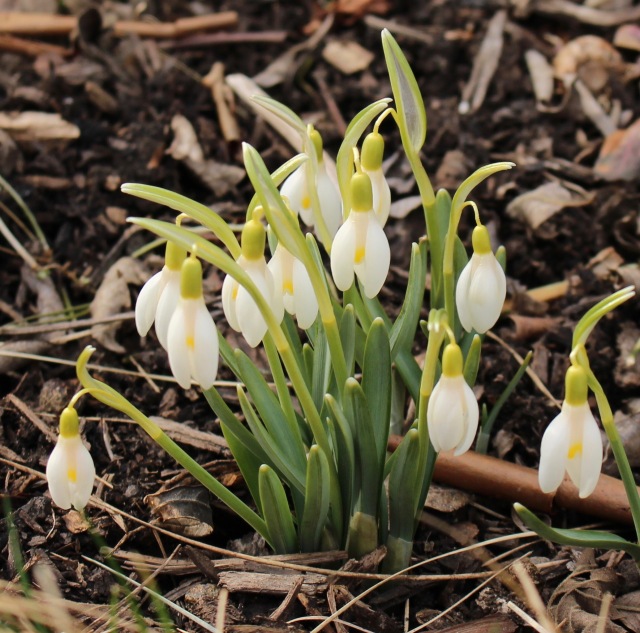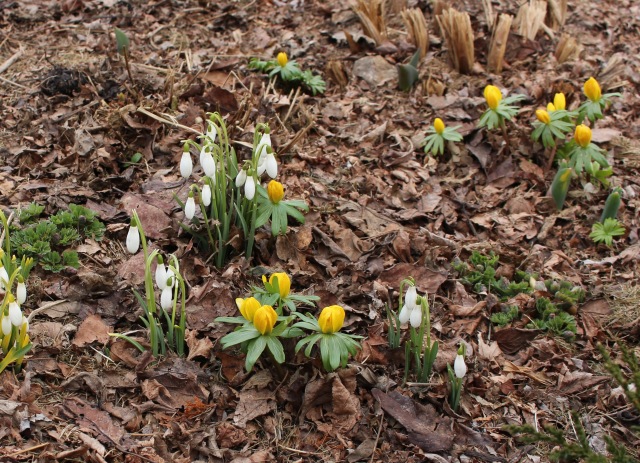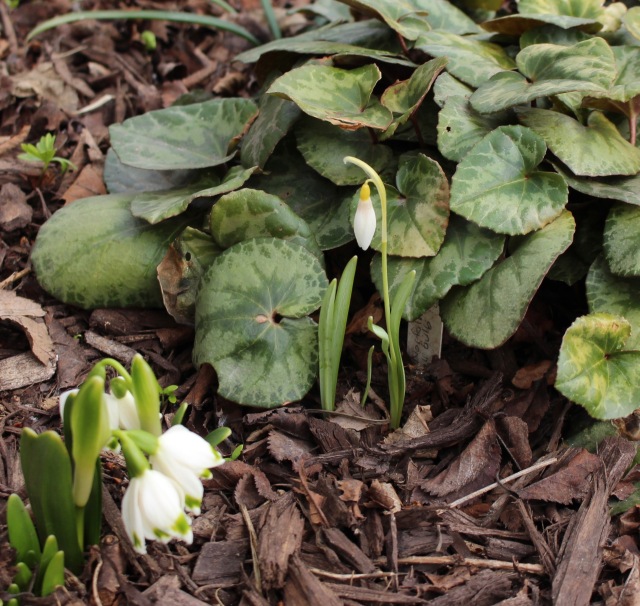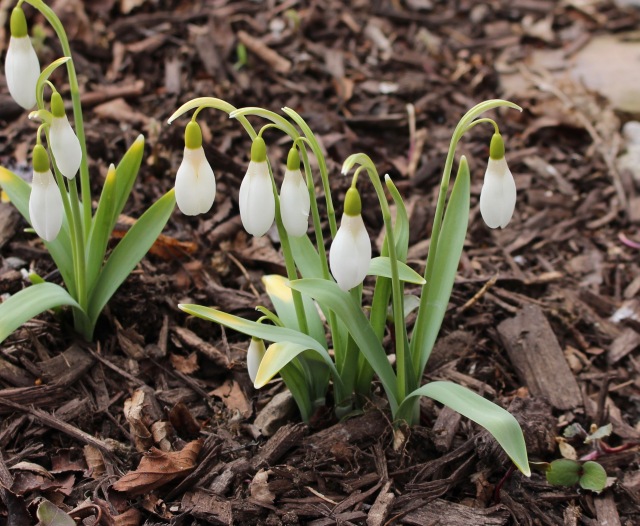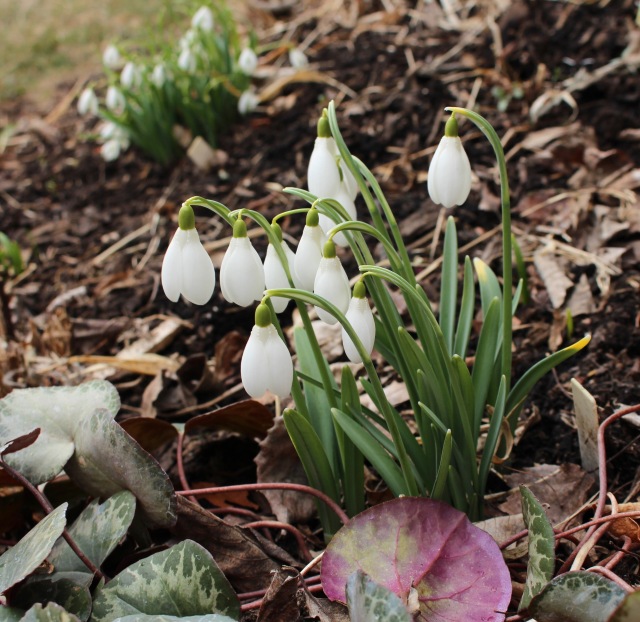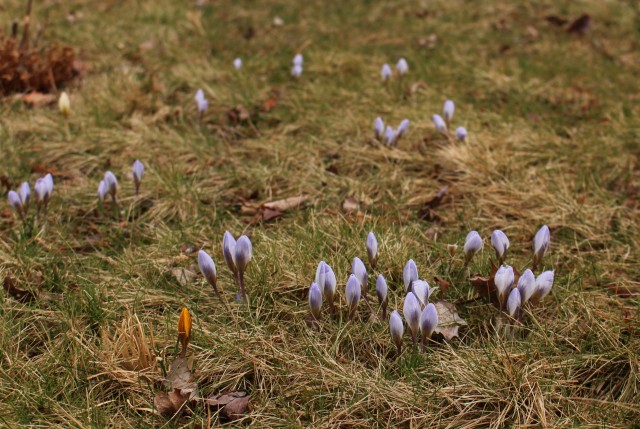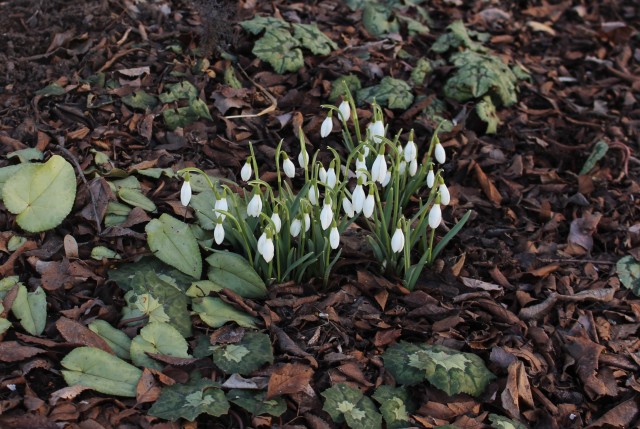The weather has suddenly caught up to the calendar and we’ve been suddenly and brutally been thrown into our first hot (90F, 32C) days of the year. I was battling cold and the chance of flurries Sunday and by Tuesday we’re turning the air conditioning on. Go figure. Better get some pictures and a post up before the tomatoes start ripening.

The last of the corydalis. These are in a shaded spot and later than the rest, and of course I’m already looking for new ones since I love the darker tips on short little ‘Domino’ 🙂
I was enjoying the long, cool, spring, but with two days of hot winds and beating sun everything has jumped ahead again. I always fall behind on posting at this time of year, but this post has really got to go up quick since by tomorrow morning I suspect most of these flowers will have been done in by the weather….

Plain old Corydalis solida. I was a little ‘meh’ for the first few years, but now that they’ve settled in I must say I like them.
The hellebores will hopefully still have another week or so in them. Without any late freezes it’s been a great year, and I’m suddenly itching to grow a few more!

Seedlings out in the street border. The heavily speckled ones are some of my favorites, but then so are the dark ones, and double ones, and yellow, and….
I grow a few from seed every year, and would have started many more but lately it seems I’ve been running out of room. The words ‘thinning the herd’ have come up, and now I’m looking at a few plants with a critical eye and an eager shovel. I need room for more seedlings, my favorites deserve a chance to spread their seed ;).

These are purchased doubles from the O’Byrnes out in Oregon. It’s ‘Golden Lotus’ in front and possibly ‘Peppermint Ice’ behind. These would qualify as ‘favorites’.
I’m probably being delusional. It would be a struggle for me to get rid of any of the hellebores, even the ones which might deserve the ‘less pretty’ title, and in case it’s not already obvious, I really lack the focus and conviction to ever draw a line with plants. Who knows though, one afternoon anger management might fail me and out they will come.

The queen bumble bees are out, and hopefully they’re getting plenty of the nectar and pollen they need to start this season’s family… and doing a little pollination on the side of course.
This spring even the messiest, most unevenly colored hellebore ends up being a favorite. Green flowers in particular win me over immediately.

The first year flowers on a new hellebore seedling are always the most exciting.
Green flowers and other ‘curious’ blooms are always welcome here and this year I’m seeing a little success in that always curious plant group, the fritillarias. Fritillaria uva vulpis, aka fox’s grapes, is back for a second year and even though it took the convincing of a friend to sway me towards keeping them, I’m glad now that I did. They at least look a little ‘interesting’ rather than the straight ‘blah’ I saw last year, and perhaps they’ll continue to improve next year as well.

Fritillaria uva vulpis. It might not hold up to a bank of golden daffodils but surely it still makes the garden a better place.
The snake’s head fritillaries (Fritillaria meleagris) are showing off as well. I love them, and and it makes me happy to see seedlings and clumps forming as they settle in to the soggiest parts of the garden.

This clump really lives up to the name snake’s head fritillaria. I can even see eyes!
The white ones add a little contrast, but the checkered patterns and colors of the darker ones really wow me as they unfurl each spring. Fyi I’ll need to spread the seeds of these around as well!

Fritillarias have some of the coolest flower patterns.
By the end of last week the front border was at a peak with all the leftover hyacinths, corydalis, and the start of the midseason daffodils. From the right angle the bed looks packed with color and I was thrilled, and a few days later it still looks nice but half of what was in flower has been melted by the heat. Now the first tulips are coming on, and hopefully in a few day you’ll tolerate a few photos of that as well!

The front street border. Spring is here 🙂
Here are a few highlights along the curb.
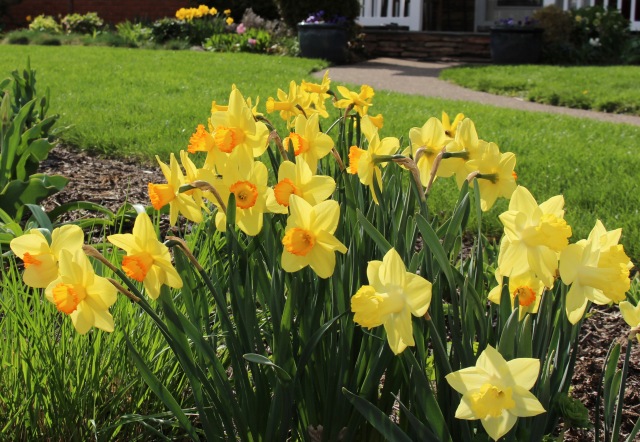
Maybe ‘Red Rascal’ and and definitely ‘Pistachio’. The pale yellow ‘Pistachio’ has been a favorite for years.

The first flowers on one of the moneyplants (Lunaria annua ‘Rosemary Verey’). This is the first year I’m seeing the purple stained foliage and stems for which this strain is know.

A magnolia cutting swiped from a layered branch on the neighbor’s tree. It’s nothing special I’m sure, but having grown it from a cutting makes it absolutely special. Of course I need more.
Behind the house the back garden is showing off as well. In three days all the green has turned to flowers!

Vegetable beds are much more successful when not filled with daffodils. My bad.
Flowers aren’t the only color out there. This spring I’m finally seeing the awesome foliage which inspired me to hunt down my very own plant of Iris x robusta ‘Gerald Darby’. Thanks to Nan Ondra and her blog at Hayefield, I’ve been coveting this plant for years. Now I’m seeing that the wait was worth it.

‘Gerald Darby’ also has pale blue flowers which follow the purple foliage. As the shoots expand, the color will fade to green.
I’ll spare you most of the other foliage photos, and the overabundance of daffodil photos to just leave you with a few more scenes from around the garden. The primroses enjoyed last summer’s rain and look promising for once in their (short) lives… such a refreshing change from their usual near-death appearance.

Some of the first plants to come in to bloom. This peachy sunset flower doesn’t show up well in the garden, but close up it’s delicious 😉
Under the weeping cherry the three day cherry bloom is over, and the spent petals are now decorating the ground. It’s a perfect complement to the last of the hardy cyclamen, which (not to rub it in) have been blooming since March, through storm and ice and heat, -unlike the short lived cherry.

The last flowers on the Cyclamen coum.
While the earliest bloomers are still up and growing and building energy for next year, it’s a great time to do a little moving around and dividing. I created what I hope will soon become my very own trailer park snowdrop bed. It’s filled with the most messy and common double flowers, the ones all the classier growers look down on such as ‘Flore pleno’ and her variously marked variations such as ‘Pussey Greentips’ and ‘Lady Elphinstone’. I’m sure someday they will grow to wow even the most rarefied galanthophile.

Snowdrops are classy but only if you avoid decorating the surroundings with plastic children’s toys, plastic buckets, and stray leaf bags. I’d also be more impressed with this new planting if the big rock at the front was already moved out of the new pathway. Obviously it would be easier to put the path elsewhere.

Two days ago the tulips were mostly closed and the bleeding hearts still a deep, rich carmine. Today they all opened and the hearts are faded. Still nice though!
While I’m moving snowdrops and boulders hopefully I’ll still have the time to enjoy a few daffodils and tulips. They’re opening as we speak and hopefully the winds and downpour which are barreling through this afternoon will spare a few. I managed to take one last photo out the back door before the storm hit and as you can see it was full on spring today.

The potager on the verge of tulip season. For the record there are onions and lettuce in there as well.
My fingers are crossed for the weekend. If things work out as planned there will be plenty of time and energy for all the things which need doing… if history repeats itself there will be plenty of sitting around and little work. We’ll see who wins.
For the record I’ve spent $15 on pansies and then $14 on lettuce and more pansies. The rabbits have already eaten about $8 worth of the lettuce. It happens. Have a great weekend!
$15 for an exceptionally restrained first visit to my favorite garden center
$14 lettuce, onions, and more pansies, also essential
$576 total so far for the 2018 gardening year.
